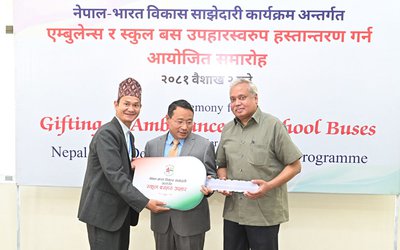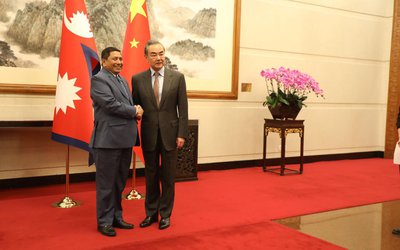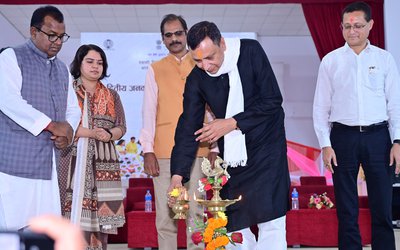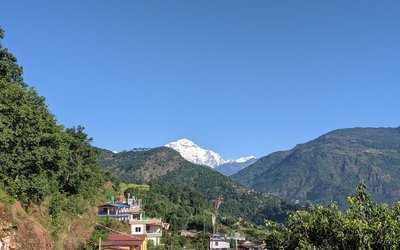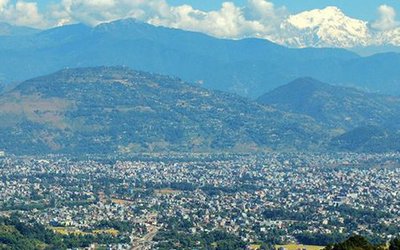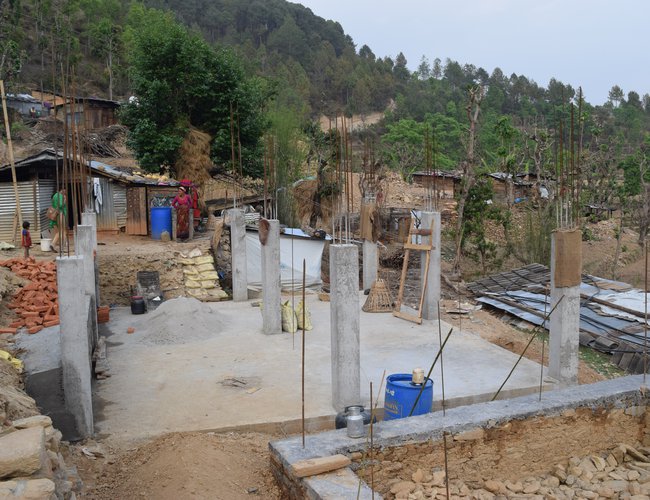
After waiting for almost two years and failing to secure the government grant, Jyoti Giri of Chautara, Sagachok Gadhi, decided to build her house on her own. As she saw no immediate possibility to get the grant money from the National Reconstruction Authority (NRA), Giri, 45, went to a local cooperative and secured Rs.300, 000.000 (three hundred thousand rupees) in loan at an annual interest rate of 20 percent.
She built a two-bedroom house, with a kitchen, at a cost of about Rs.500.000.000 (Five hundred thousand rupees). “As soon as we secured the first installment Rs. 50,000.00 (Fifty thousand rupees) in November, we decided to prepare the foundation. However, the money provided by NRA was so small that it was not even enough to clear the debris of the house,” said Giri.
“As we lost the faith in being able to secure the money, we went to a cooperative seeking loan in hopes that the second and third installments would be released by the government so we could repay the loan. As there is a no sign of distribution of the second and third installments any time soon, we are forced to pay an additional interest rate.”
Giri and her family are not alone in the village to have waited for two years to reconstruct the house. An overwhelming majority of people in Sindhupalchowk district are living in temporary shelter with an uncertain future.
“Had the government not promised, all the villagers would have built their permanent shelters by now. We did not have our own house to live in for two years because we trusted the words of the government and political leaders,” said Giri.
Saila Tamang, 50, of Melamchi Municipality, Ward No. 2, Bahunpati, has a different experience to share. “I received the first installment from the government but the money was too little to do anything to reconstruct the house as per the building design provided by NRA,” said Tamang. “I was told that I needed to complete the foundation work to qualify for the second installment. As I have not completed the foundation, I don’t know whether I will qualify for the second and the third grants.”
Not only in Sinduhpalchwok, the situation in Kavre and Dolakha districts, is similar as a majority of earthquake victims are living in their temporary shelters.
As the government failed to provide the grant installments in time, the people are building the houses on their own ways. These people are reconstructing the houses employing trained masons and using cement, concrete and iron, but they are not following the building codes required for earthquake resilient houses.
Trained by World Vision International Nepal, JICA and UNDP in different times, fifty-one year Amar Bahadur Giri, a local mason, has already constructed over 50 houses in the last one year. He claims that he used all the techniques learned to build the earthquake resilient houses.
As engineers and overseers did not visit the sites for inspection and certify the houses as earthquake resilient, the people believed that the new buildings would not collapse like that of the past one because they used iron rod, brick and cement in the foundation.
“I am carefully using all my old skills and techniques learnt during the training in house construction. Unlike in the past, we used the mud and stone at all levels and we don’t care about the joins of the building. I claim that this is perfect and will resist the earthquake,” said Giri, showing houses in Irkhu village, where a construction boom is now underway. “Had we waited for engineers and overseers from Chautara, we would not have made a single house.”
In the absence of adequate engineers and overseers, the reconstruction boom is now happening under the leadership of masons trained by various international agencies. One positive part is that people do not employ masons without training given by outside agencies in reconstruction.
“We are employing trained masons. Unlike in the past, the trained masons are using tie-beam, cement, brick and concrete at the foundation," said Bishal Giri, a resident of Gothpani of Chautara, who has already moved to his new house. “With the support from all the communities, most of the people are in the process of building houses on their own. We don’t have more patience to wait.”
NRA’s Slow Move
Constituted almost a year after the earthquake to accelerate the reconstruction work, National Reconstruction Authority (NRA), a high-level body, failed to carry out its assignment effectively. As the pace of earthquake reconstruction moved slowly, the government dismissed CEO Sushil Gyawali and appointed Professor Dr. Govinda Raj Pokharel, former vice chairman of the National Planning Commission, as the new CEO just months ago.
Within two months of his appointment, Professor Dr. Pokharel has taken certain initiatives to accelerate the reconstruction work. “I know the things have not been moving at the pace as desired. NRA is taking new initiatives and making necessary arrangements to accelerate the pace,” said Professor Dr. Pokharel. “My target is now to distribute the money and send victims to their newly-built earthquake resilient homes by next year.”
As the monsoon is approaching and the country is busy with the local elections, the reconstruction work is no body’s priority. In the absence of civil servants, the process of distribution will not begin before July.
“NRA is searching for alternatives to continue the process of distribution of grants even at the time of elections and clear the files of development partners, NGOs and INGOs,” said CEO Professor Dr. Pokharel. “ The process will be accelerated after elections.”
In 14 hard-hit districts, 626695 victims have already benefited from the NRA grants. Out of them 562,278 have signed grant agreement and 543,606 received the first installment. According to NRA, 49681 houses were built by the earthquake victims. Out of 34294 applicants for second installment, 14557 files have already been certified. There are 18633 houses built without grant.
According to joint secretary Yam Lal Bhoosal, housing reconstruction in 14 districts has started with the participation agreement, identifying 90,556 beneficiaries. Grant distribution has been started from 5th April 2017 and participation agreement made with 155 and first tranche distributed for 50 so far.
“Although the present pace is not above satisfactory, we have made a good progress in many areas. Our success in the reconstruction is over eight percent in some sectors,” said Bhoosal, joint secretary of NRA.
Success In School Reconstruction
At a time when the pace of reconstruction of individual houses is very slow, there is a good progress in school reconstruction. This was possible because of involvement of bilateral agencies and INGOs and INGOs directly in reconstruction.
Out of 7923 schools, JICA will support construction of 283 schools in 6 districts. Out of them 83 schools are under construction. Out of 160 schools under Asian Development Bank in 8 districts, 49 are under construction.
Although INGOs and NGOs are blamed for mishandling reconstruction, INGOs and NGOs have shown that they are more effective. Out of 1250 under INGOs and NGOs, 925 are under construction and 325 have already been completed. Under School Management Committees, 816 classrooms have already been completed in 17 districts.
Out of 750 damaged heritage sites, construction of 90 sites has already been completed. During the period, 34243 masons were trained for their short term and long term training.
Budgetary Constraints
The total pledge of donor money was US$ 4,109,519,915 and net pledge 3,609,519,915. The total commitment was 3,066,209,950, which is 84.95 percent and on budget treasury 1,543,778,141 or 50.35 percent. On budget, the amount is 1,711,772,641 or 55.83 percent against commitment.
The budget gap is growing. In housing construction, the previous government increased the grant amount from Rs. 200,000.000 to 300,000.000 without taking the budget into account. Thus there is a gap of Rs. 142,993,850,000 in housing. The budget gaps are also affecting reconstruction of schools, including university buildings.
There is a gap of budget Rs. 124,000,000,000 in schools and universities, Rs. 18,400,000,000 in heritage sites, government buildings Rs.12,800,000,000, health institutions Rs. 10,250,000,000. The total gap is Rs. 308,443,850,000.
Joint secretary of NRA Bhoosal said in his paper presented at seminar on 2nd Anniversary of Gorkha Earthquake that the budget gap is also creating obstruction for reconstruction and re-emphasized BBB-Based Recovery.
“Although there are many challenges in expediting recovery work, the message of BBB has reached villages where people now understand how to build resilient houses, thanks to various partners’ support,” said Dr. Govinda Raj Pokharel, Chief Executive Officer of the NRA.
“There is no doubt about recovery and reconstruction from the EQ being the most imperative issue. However, drawing the lesson from recovery and reconstruction process and utilizing it for making disaster resilient society in continuum are equally important,” said Jun Sakuma, Chief Representative of JICA Nepal
Ambassador of Japan to Nepal Masashi Ogawa said, “as a true friend of Nepal and a country with a long history of natural disasters, Japan will continue to support the effort to Build Back Better in Nepal.”

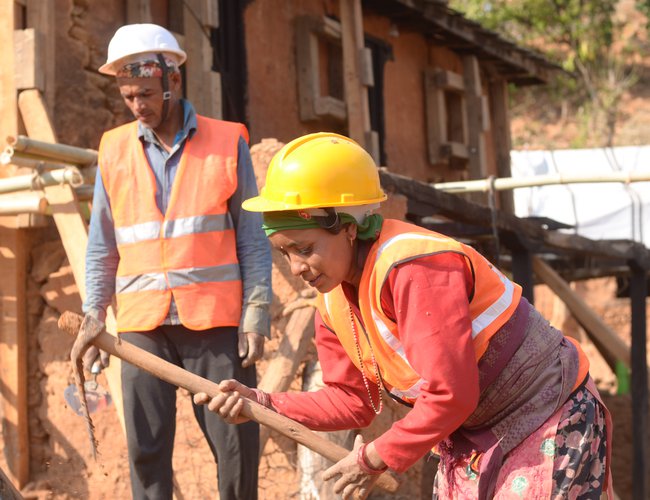

Keshab Poudel
Poudel is the editor of New Spotlight Magazine.
- ECONOMY: Growth At 3.3
- Apr 16, 2024
- DPM’s SHRESTHA’S CHINA VISIT High Profile, Low Key
- Apr 14, 2024
- Maha Kumbha In Barahkshetra: A Sacred Festival In Sacred Koshi (Kaushiki) River
- Apr 09, 2024
- LOSS AND DAMAGE: Upper Tamakoshi A Case
- Apr 02, 2024
- Helvetas-Nepal’s InElam Promoting Herbal Oil In Sarlahi
- Mar 31, 2024

Keshab Poudel
Poudel is the editor of New Spotlight Magazine.
- ECONOMY: Growth At 3.3
- Apr 16, 2024
- DPM’s SHRESTHA’S CHINA VISIT High Profile, Low Key
- Apr 14, 2024
- Maha Kumbha In Barahkshetra: A Sacred Festival In Sacred Koshi (Kaushiki) River
- Apr 09, 2024
- LOSS AND DAMAGE: Upper Tamakoshi A Case
- Apr 02, 2024
- Helvetas-Nepal’s InElam Promoting Herbal Oil In Sarlahi
- Mar 31, 2024




